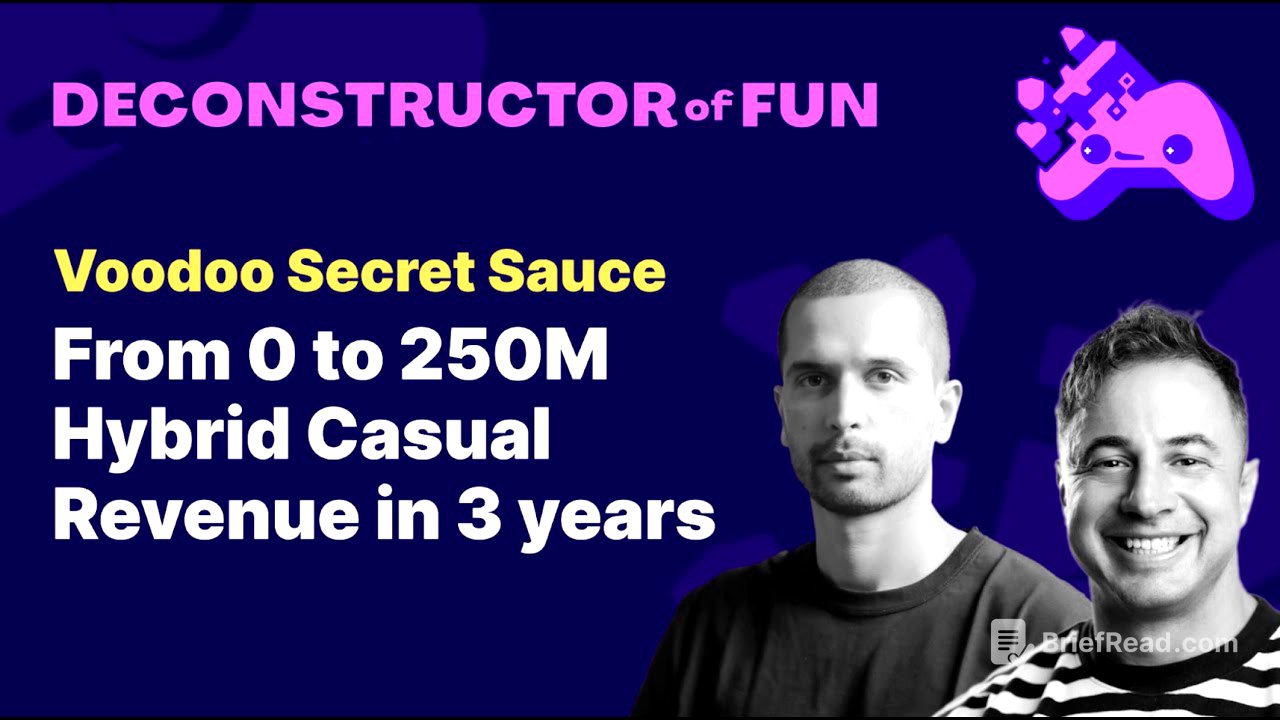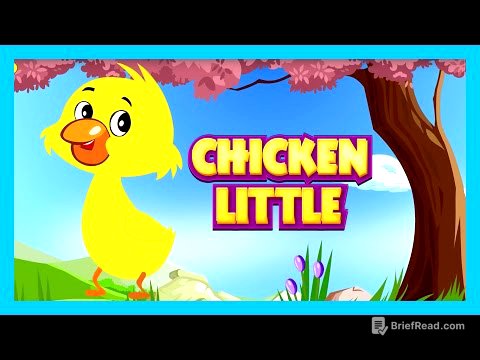TLDR;
This podcast features Gabriel Ru, VP of Gaming at Voodoo, discussing Voodoo's evolution from hyper-casual to hybrid-casual games. He talks about the impact of Apple's privacy changes on the hyper-casual market, Voodoo's transition strategy, and the importance of team structure and culture. He also shares insights on identifying and working with successful game studios, and Voodoo's approach to data-driven decision-making and innovation.
- Voodoo transitioned from hyper-casual to hybrid-casual due to changes in ad monetization.
- They now focus on innovation, performance, and ownership.
- They look for talented GMs to build iconic games.
Introduction to Voodoo and Gabriel Ru [0:00]
Gabriel Ru, the VP of Gaming at Voodoo, has been with the company for eight years. Voodoo is a major player in the gaming industry, generating $600 million in revenue in 2023 with $100 million in earnings. They have reached 7 billion lifetime downloads and boast 150 million monthly active users. Voodoo employs 750 people, with 500 dedicated to game development. The discussion will cover Voodoo's journey, including hyper-casual and hybrid-casual games, and how they've maintained a scalable business model over time.
The Shift from Hyper-Casual to Hybrid-Casual [2:00]
Voodoo's downloads have decreased from a peak of 500 million per quarter in 2020 to around 130 million recently. This shift reflects a change in business model from hyper-casual to hybrid-casual games. By 2023, 50% of Voodoo's revenue came from in-app purchases, not ads. While they no longer develop hyper-casual games, their existing portfolio still generates 25% of revenue. Hybrid-casual games have fewer downloads but better monetization. Hyper-casual games are straightforward, engaging, and marketable with a focus on new and innovative gameplay. They rely heavily on ad revenue. Hybrid-casual games have more engaging core gameplay, longer player retention, and a mix of in-app purchases and ads for monetization, typically a 50/50 split.
Defining Hyper-Casual vs. Hybrid-Casual Games [2:56]
Hyper-casual games have a very straightforward and engaging gameplay, are easily marketable, and focus on innovation. They monetize almost entirely through ads. Hybrid-casual games have a more engaging core gameplay, leading to longer player retention, and monetize through a mix of in-app purchases and ads. Design-wise, hybrid-casual games start with a hyper-casual core, then add progression and live ops to build retention. Monetization combines in-app ads and purchases related to meta-progression. Marketing aims to acquire users at hyper-casual prices but monetize them with in-app purchases. Production maintains a fast pace with testing, but also includes live ops.
The Death of Hyper-Casual Games [7:26]
Voodoo experienced five years of hyper-growth in the hyper-casual genre, but this ended with Apple's privacy changes. Apple required apps to get explicit consent to track user data, impacting ad targeting. Without this data, ad networks couldn't match the right ads to the right players, increasing CPI (cost per install) and decreasing CPM (cost per thousand impressions). This compression effect reduced margins, making hyper-casual unsustainable. The high IPM (installs per thousand impressions) that made hyper-casual successful was affected. CPM went down on the monetization side and up on the acquisition side, creating a double whammy.
Voodoo's Transformation and Team Structure [11:24]
Voodoo started exploring in-app purchases in 2018 because they felt LTV was capped due to ads. They initially tried integrating this with existing hyper-casual teams but didn't succeed. After hiring the right people, they started making successful games that monetized through in-app purchases. The transformation involved creating two types of teams: Prototype teams that focus on finding new core gameplay and Life teams, composed of industry veterans, that build on the best prototypes. Prototype teams prototype a game every week, while Life teams operate the game with live ops, segmenting users, adding levels, and honing the economy.
Transitioning Games from Core to Live Operations [13:56]
Voodoo narrowed down its partner studios from 700 to 100 that could build more complex hybrid-casual games. When a good prototype is built, it's matched with a live team. The growth team manages the transition, focusing on building LTV rather than optimizing CPI in the early stages. Once the game is handed over to a life team, the growth team scales the game with more creatives and geographies. The transition from core to live takes about six to nine months. Voodoo looks for day one retention around 50% and day seven retention around 15% at the prototype stage.
Soft Launch and Full Launch Phases [16:33]
During the soft launch, the core studio continues working on the game with help from Voodoo's launch chops team, which provides engineering and artistic support. They focus on perfecting the core gameplay loop. Voodoo looks for a predicted return on ad spend (ROAS) of 150% within 120 days. Once validated, the game goes into full launch, and a live team takes over, adding features and live ops. Voodoo aims to grow the scale by 10K per month. Day 30 retention of 10% indicates a core group of players who enjoy the game.
Team Dynamics and External Studios [19:56]
The core team gradually loses access over 18 months, with the live team general manager becoming the main decision-maker at full launch. The core team eventually returns to prototyping. Voodoo makes it clear from the start whether a team will work on prototypes or live games. About 70% of Voodoo's core studios are external. Voodoo communicates clearly with studios and makes contracts very clear from the beginning. Revenue share splits are adjusted when the game is handed over to the live team.
Identifying and Working with Hit Studios [24:29]
Voodoo looks for studios where the team's life mission is to make games. Core studios are usually small, with team members having multiple skills. Voodoo coaches studios through a Socratic method, letting them test ideas while providing learnings from previous tests. Training new studios can take up to a year. Voodoo has 10 publishing managers who coach studios daily.
Voodoo's Culture and Operations [27:57]
Voodoo tests around 1,000 prototypes per year, with 10% being iterated on, 30% going into soft launch, and only four making it to full launch. One of those four becomes a big hit, sustaining a $100 million run rate per year. Voodoo aims for a 40% profit margin. They have around 100 prototypes being prototyped at any given time. Voodoo's culture is performance-driven, with a focus on ownership and innovation. Product teams have ownership over their roadmaps and can earn up to 10% of a game's profit.
Voodoo's Culture and Global Ambitions [31:57]
Voodoo's headquarters focuses on publishing, growth, engineering, and data, while the studios are remote with their own cultures. The company is performance-driven, emphasizing ownership and innovation. They aim to find unexplored spaces in gaming. Inspired by Silicon Valley companies, Voodoo has created its own unique culture. English is the main language, with 40 nationalities represented. Voodoo is scaling and hiring globally, particularly in Turkey, Israel, and Eastern Europe.
Final Thoughts and Advice [35:57]
Gabriel emphasizes that the market has changed, with Voodoo transitioning from hyper-casual to hybrid and now towards casual games. They've tested over 20,000 games, with successes like Mob Control and Block Jam. Voodoo seeks talented general managers with the will to build iconic games, a performance-driven mindset, and a willingness to take ownership of the game and its profits.









